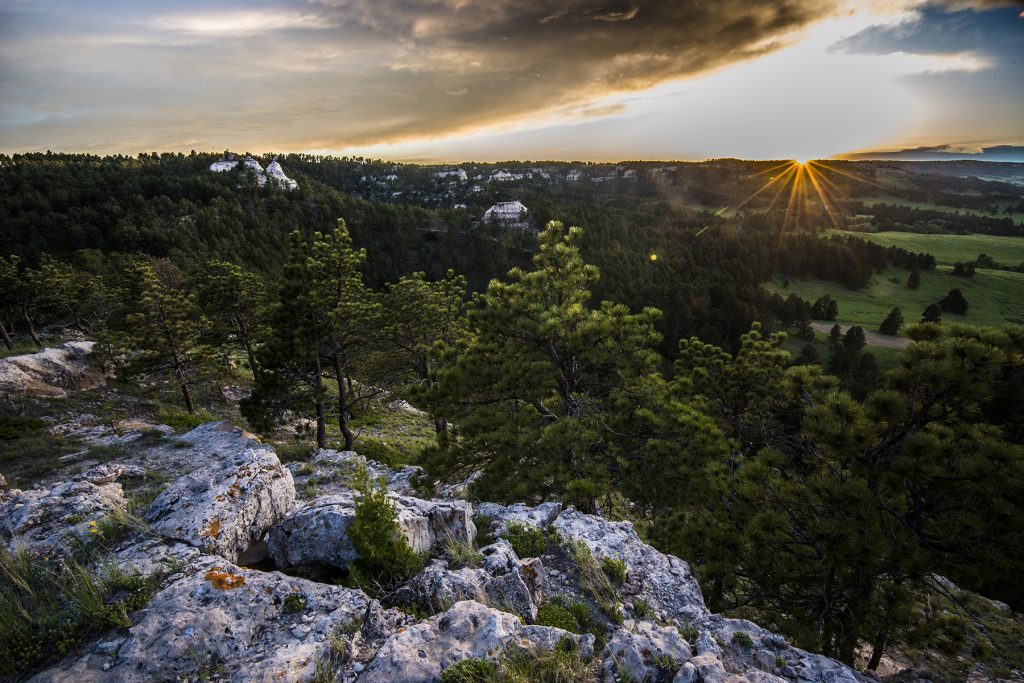Harrison bills itself as “Nebraska’s Top Town,” which is mostly a play on the village’s elevation of 4,876 feet — the highest of all Nebraska communities. Also tops, though, is the scenery and natural beauty of the surrounding landscape, certainly not the least of which is Gilbert-Baker Wildlife Management Area about 6 miles north of town. Here are some images from a recent visit to this remarkable public land.
Perhaps one of the best examples of the serenity of Gilbert-Baker is an image of the night sky unhindered by light pollution. While I seem to have been the only person around for miles at the time and location of these photos, it was especially awe-inspiring to consider the distance of all those celestial bodies decorating nature’s “ceiling” that night. Jupiter, the brightest of the bunch and largest of our solar system’s planets, ranges from 365-601 million miles away from earth on an elliptical orbit around the sun. Life as we know it on earth is a remarkably rare, precious and perhaps even unique thing, but with approximately 100 billion stars in our photogenic Milky Way galaxy alone, I like to believe there were some other life forms working to capture this beauty at points of the universe away from earth that night. I hope the endeavor was as good for their souls as it was for mine.
The backlit fluffy seed head of goatsbeard (Tragopogon dubius), also known as western salsify, makes an attractive macro photo subject against the setting sun – and, on this evening, a preferred place for this grasshopper to hang out. If conditions are right, those parachute-like seeds can travel hundreds of meters from the plant. While the seed heads and its yellow flower certainly resembles dandelion, goatsbeard has a better reputation among land managers than that plant does.
Here’s a plant that certainly does not have a good reputation, and I won’t count it among the beautiful things I saw during this trip. Houndstongue (Cynoglossum officinale), with its seeds that cling to clothing, ranks high on my list of annoyances from the field. It has become especially prevalent in certain parts of northwestern Nebraska. I am getting pretty good at recognizing and avoiding this plant when it becomes brown, as it is for most of the year. This solo green plant, in a place where little houndstongue was present, made a sneak attack on my clothing, though. As a matter of revenge, I chopped the plant down and took the seeds off the property to be destroyed. Take that, houndstongue.
I was rewarded with decor of stemless hymenoxys (Tetraneuris acaulis) by hiking to one of the butte tops for a sunset photo. Jon Farrar noted in his Field Guide to Wildflowers of Nebraska and the Great Plains that this sunflower of the Panhandle and western Great Plains seems to have an inappropriate name at first glance. However, “the slender leafless ‘stems’ that bear the flower heads are technically flower stalks (scapes). The true stems, bearing leaves, if present at all, are short and inconspicuous in the basal leaves,” he wrote.
Pretty tough to beat misty mornings in the Pine Ridge.
Gilbert-Baker features the best of two remarkable worlds – where the pines meet the grasslands.
These American kestrels (Falco sparverius), which belong to the smallest raptor species in North America, were fun to watch as they performed an aerial show overhead. I have yet to find any resources that mention kestrels flying upside down, as the two in the bottom photo briefly did, but it was fun to witness, regardless.
You’ve gotta love the “I’ll grow where I want to grow” attitude of ponderosa pine (Pinus ponderosa) trees. I’ve seen people go to great lengths to get them to grow on seemingly fertile soil, only to watch them shrivel up and die. Then, you find a place like this where one has sprouted from a rock, eventually apparently splitting it in two, and you surely admire its persistence.
On this particular morning I didn’t witness as much wildlife activity as hoped while I was tucked into a blind. I was glad to see this northern flicker take advantage of the view atop an old distinct snag at the edge of the WMA’s pond, however.
Here are a couple of interesting comparison photos a location in Gilbert-Baker, which display its undeniable beauty — and more. I shot the top one in 2018 and the other this year. In the distance is a service road, before and after it was cleared of nearby ponderosa pines this summer. If a wildfire ever ignites in this rugged area, firefighters will surely be glad to have that road to make a stand against it and be thankful for the other thinning that was done nearby. It is just one great example of the work the Nebraska Game and Parks Commission, National Wild Turkey Federation, Nebraska Forest Service and other partners are doing to prepare against such a dreaded event and keep pines in the Pine Ridge.
The post Summer beauty at Gilbert-Baker WMA appeared first on Nebraskaland Magazine.































